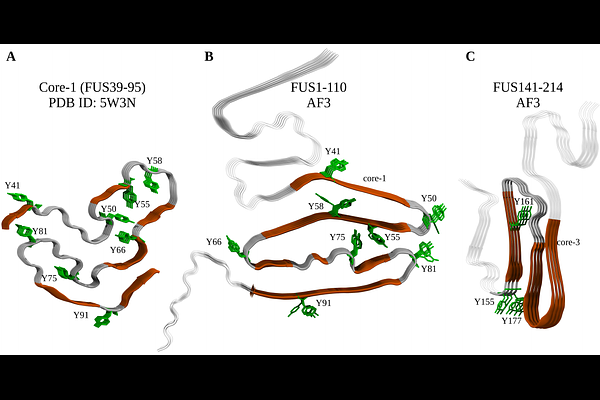Droplet growth, Ostwald's rule, and emergence of order in Fused in Sarcoma

Droplet growth, Ostwald's rule, and emergence of order in Fused in Sarcoma
Maksudov, F.; Mugnai, M.; Makarov, D.; Thirumalai, D.
AbstractThe low complexity domain of Fused in Sarcoma (FUS-LC consisting of 214 residues) undergoes phase separation, resulting in a dense liquid-like phase that forms early and slowly matures to reach ordered gel-like state on long time scales. Upon maturation, core-1, comprising of the 57 residues (39-95) in the N-terminus become structured, resulting in the formation of a non-polymorphic fibril. The truncated FUS-LC-C (residues 110-214) construct forms a fibril in which core-2 (residues 112-150) adopts a {beta}-sheet structure. Using coarse-grained monomer SOP-IDP model simulations of FUS-LC, we predict that residues 155-190 in the C-terminal (Core-3) form rapidly, followed by core-2, and finally core-3. The time scale of formation of the cores and their stabilities are inversely correlated, as anticipated by the Ostwald\'s rule of stages. Unbiased multichain simulations show that the chemical potentials in the two phases are equal and the calculated densities of the dense and dilute phases are in agreement with experiments. The dense phase, which forms by a nucleation mechanism, coarsens over time by a process that is reminiscent of Ostwald ripening. AlphaFold predictions of the core-3 structure and the simulations show that {beta} strand emerges in the core-3 region early during the droplet formation, and drives the initiation of FUS-LC assembly. The techniques introduced here are general and could be used to probe assembly of other IDPs such as TDP-43, which shares many features with FUS-LC.